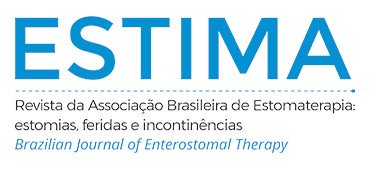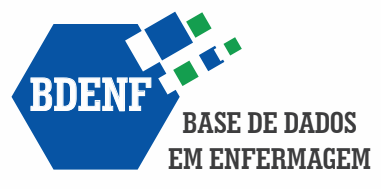Skin care for toxic shock syndrome: case report
Abstract
Objective: Toxic shock syndrome (TSS) is a severe multisystemic condition caused by Staphylococcus aureus or Streptococcus pyogenes, and initial management of skin lesions is essential for infection control. This article aimed to describe skin care for TSS. Case report: We report a man with a hip abscess who developed fever and hypotension and was subsequently transferred to an intensive care unit (ICU). He was diagnosed with septic shock, probably of hip origin, and was immediately treated surgically for local infection control. He presented with renal failure besides multiple organ dysfunction (hepatic and cardiac), hemodynamic instability, and disseminated skin lesions. With the isolation of Staphylococcus aureus, clindamycin was initiated, and the diagnosis was TSS due to epidermolytic lesions since the onset of the condition. Cutaneous recovery measures were initiated with silver sulfadiazine, followed by silver hydrofiber with skin recovery in 8 days. After 10 days of skin recovery, the patient was discharged from the ICU to the ward with maintenance of the proposed treatment. Conclusion: In this case, the use of hydrofiber showed satisfactory performance; however, robust studies are needed to confirm such efficacy.
Downloads
Metrics
References
de Mello JA, Pachelli LC, de Gões Filho JF, Villardi N, Consani R, Guidugli RB. Death due to probable toxic shock syndrome, after attempted abortion. Rev Paul Med. 1987;105(2):116-7. PMID: 3432881.
Carvalho HT, Fioretto JR, Ribeiro CF, Laraia IO, Carpi MF. Diagnosis and treatment of streptococcal toxic shock syndrome in the pediatric intensive care unit: a case report. Rev Bras Ter Intensiva. 2019;31(4):586-91. https://doi.org/10.5935/0103-507X.20190068
Rodríguez-Muñoz L, García-Galván Ó, González-Soto MÁ, Echániz-Avilés G, Solórzano-Santos F. Toxic shock syndrome caused by Streptococcus dysgalactiae subsp. equisimilis in a Mexican preschool patient. Bol Med Hosp Infant Mex. 2019;76(5):237-40. https://doi.org/10.24875/BMHIM.19000095
Antunes R, Diogo M, Carvalho A, Pimentel T, Oliveira J. Streptococcus pyogenes toxic-shock syndrome. Acta Med Port. 2011;24:617-20. https://doi.org/10.20344/amp.1555
Vázquez García RE, Hernández Bautista V, Espinosa Padilla S. Superantigens and toxic shock syndrome. A report of three cases treated with intravenous gammaglobulin. Rev Alerg Mex. 2006;53(5):183-8. PMID: 17357565.
Alvares PA, Mimica MJ. Síndrome do choque tóxico. Arq Med Hosp Fac Ciênc Med Santa Casa São Paulo. 2012;57(2):81-4.
Amerson SJ, Hoffman M, Abouzahr F, Ahmad M, Sterling RK, Gidwani H, Sousse LE, Dellavolpe JD. Sequential extracorporeal therapy of pathogen removal followed by cell-directed extracorporeal therapy in streptococcal toxic shock syndrome refractory to venoarterial extracorporeal membrane oxygenation: a case report. Crit Care Explor. 2024;6(3):e1058. https://doi.org/10.1097/CCE.0000000000001058
Pina C, Carvalho I, Teixeira M, Rodrigues G. Síndrome de choque tóxico estafilocócico. Arquivos de Medicina. 2009;23(1):10-2.
Wilkins AL, Steer AC, Smeesters PR, Curtis N. Toxic shock syndrome – the seven Rs of management and treatment. J Infect. 2017;74 Suppl 1:S147-52. https://doi.org/10.1016/S0163-4453(17)30206-2
Ayala-Gaytán JJ, Martínez-Vela A, Náñez-Terreros H, Guajardo-Lara CE, Valdovinos-Chávez SB. Necrotizing fasciitis, myositis, arthritis, and streptococcal toxic shock syndrome caused by group G Streptococcus. Report of one case. Rev Med Inst Mex Seguro Soc. 2014;52(4):458-61. PMID: 25078751.
de Almeida OM, Modolin M, Neves RI, Horibe K, Vieira JC, Ferreira MC. Toxic shock syndrome after reduction mammaplasty: a case report. Rev Hosp Clin Fac Med Sao Paulo. 1992;47(6):285-9. PMID: 1340621.
Case definitions for infectious conditions under public health surveillance. Centers for Disease Control and Prevention. MMWR Recomm Rep. 1997;46(RR- 10):1-55. PMID: 9148133.
Wharton M, Chorba TL, Vogt RL, Morse DL, Buehler JW. Case definitions for public health surveillance. MMWR Recomm Rep. 1990;39(RR-13):1-43. PMID: 2122225.
Riley DS, Barber MS, Kienle GS, Aronson JK, von Schoen-Angerer T, Tugwell P, Kiene H, Helfand M, Altman DG, Sox H, Werthmann PG, Moher D, Rison RA, Shamseer L, Koch CA, Sun GH, Hanaway P, Sudak NL, Kaszkin-Bettag M, Carpenter JE, Gagnier JJ. CARE guidelines for case reports: explanation and elaboration document. J Clin Epidemiol. 2017;89:218-35. https://doi.org/10.1016/j.jclinepi.2017.04.026
Bartlett P, Reingold AL, Graham DR, Dan BB, Selinger DS, Tank GW, et al. Toxic shock syndrome associated with surgical wound infections. JAMA. 1982;247(10):1448-50. PMID: 7057535.
Cone LA, Woodard DR, Byrd RG, Schulz K, Kopp SM, Schlievert PM. A recalcitrant, erythematous, desquamating disorder associated with toxin-producing staphylococci in patients with AIDS. J Infect Dis. 1992;165(4):638-43. https://doi.org/10.1093/infdis/165.4.638
Oliveira APBS, Peripato LA. A cobertura ideal para tratamento em paciente queimado: uma revisão integrativa da literatura. Rev Bras Queimaduras. 2017;16(3):188-93.
Wasiak J, Cleland H, Campbell F, Spinks A. Dressings for superficial and partial thickness burns. Cochrane Database Syst Rev. 2013;2013(3):CD002106. https://doi.org/10.1002/14651858.CD002106.pub4
Maciel ABS, Ortiz JF, Siqueira BS, Zanette GF. Eficácia da cicatrização tecidual em pacientes queimados tratados com sulfadiazina de prata a 1% versus outros tratamentos: uma revisão sistemática e meta-análise de ensaios clínicos randomizados. An Bras Dermatol. 2019;94(2):204-10.
Nherera L, Trueman P, Roberts C, Berg L. Silver delivery approaches in the management of partial thickness burns: a systematic review and indirect treatment comparison. Wound Repair Regen. 2017;25(4):707-21. https://doi.org/10.1111/wrr.12559
Chaganti P, Gordon I, Chao JH, Zehtabchi S. A systematic review of foam dressings for partial thickness burns. Am J Emerg Med. 2019;37(6):1184-90. https://doi.org/10.1016/j.ajem.2019.04.014
Norman G, Christie J, Liu Z, Westby MJ, Jefferies JM, Hudson T, Edwards J, Mohapatra DP, Hassan IA, Dumville JC. Antiseptics for burns. Cochrane Database Syst Rev. 2017;7(7):CD011821. https://doi.org/10.1002/14651858.CD011821.pub2
Downloads
Published
How to Cite
Issue
Section
License
Copyright (c) 2024 Paola Viana Souza Farias Farias, Diego Aprigio Garcia Gotelip, Ilana Macedo Rodrigues Borges, John Wesley Mota Brum, Michelle Morlin

This work is licensed under a Creative Commons Attribution 4.0 International License.

























